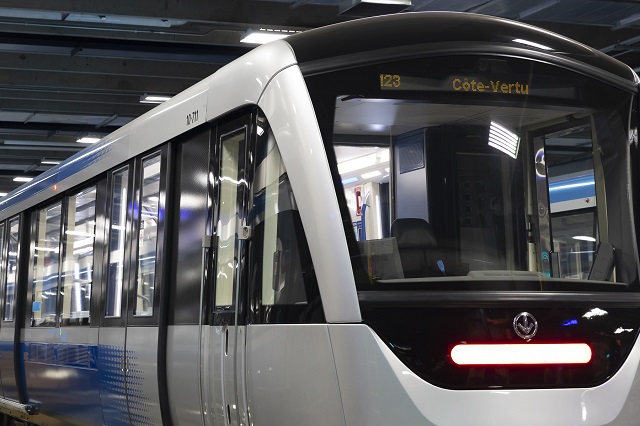The last of the new AZUR trains have now been delivered
The 71st and final AZUR train was commissioned in December 2021, completing the second phase of the acquisition. Delivery of the first batch of 54 trains was completed in June 2019. The first AZUR train was commissioned on February 7, 2016, on the Orange line.
In total, there are now 639 AZUR train cars in our rolling stock. The rest of the fleet is made up of 423 MR-73 trains.
Ten years ago, we launched the colossal project of replacing our MR-63 rolling stock, which led to the acquisition of 54 AZUR trains. Delivered on time, well under-budget and with two extra trains, the project was a success all down the line. You could even say our métro is the nicest in the world!
Ease of movement: nine-car trains allow passengers to move freely from one end to the other
Increased capacity: each train can accommodate up to 8% more passengers
Ventilation system: automatically adjusts to number of passengers in each car
27% wider doors: easier to embark and disembark; obstruction sensors
Designed to ensure universal accessibility: more and better-positioned hand grips, colours and contrasts chosen for better visibility
Optimal design and ergonomic positioning of seats
Layout of end cars: 22 fixed seats, 2 flip-up seats, 2 spaces reserved for wheelchairs, lumbar supports
Layout of middle cars: 28 fixed seats, 4 flip-up seats
Top-of-the-line soundproofing: acoustic environment for minimizing background noise
Panoramic windows: anti-grafitti and anti-scratchitti protective coatings
Innovative lighting: indirect lighting creates a more comfortable environment
Pneumatic suspension: smoother ride, less vibrations
Heightened sense of security: 3 times more intercoms, impossible to fall between cars, 4 continuous surveillance cameras
Information systems: equipped with the latest technology

Another step toward universal accessibility
The AZUR was designed to meet universal accessibility standards. Front-end platforms in stations equipped with elevators were adapted to allow customers in wheelchairs to board trains unassisted. The height of these platforms was changed to match the height of the second and third doors in head cars.
Currently, passengers in wheelchairs require assistance from STM employees to board trains.

Azur exterior design: a bold, distinctive look
Dynamic: a streamlined profile evoking strength and balance and exciting colours with a metallic finish
Modern: new technologies successfully used in other major cities, a concept tested and approved by Montrealers
Fluid: open-concept “boa” cars, increased capacity, panoramic windows
Timelessness: in line with the principles of sustainable development, designed to serve for the next four decades; a classic design anchored today's reality, primarily blue, a colour loved by Montrealers
Environmental features
Cars manufactured with 60% Canadian content, equipment that is 92.5% recyclable at the end of its useful life, 100% powered by hydroelectricity (green energy source), no more paper advertising inside trains
AZUR prototype
Assembly
Bombardier-Alstom Consortium teams and our commissioning team worked for 10 days to assemble the 9 cars.
As soon as the second car arrived, the electrical connection systems, the coupling system and intercar linkages were installed between each car to create a boa-type train.
First shower
Like in a car wash, the train moves through a soap cycle. It gets washed, scrubbed, rinsed and dried from top to bottom, even on the roof.
The washing system is equipped with markers placed at the entrance that detect whether the train is an MR-73 or a new AZUR. As the train moves forward through the washing system, sensors send out signals to activate pumps and scrubbing brushes.

The bogie
As with the MR-63 and MR-73 métro cars, the AZUR train is also mounted on bogies that essentially propel the train. Bogies, or trucks, are an assembly of parts that include tires, suspension and drive axles. Together, they handle the acceleration, braking action, steering and suspension for métro trains.
If you want to know more about the bogies on AZUR cars, check out the video.
Lifting track
In preparation for the arrival of the AZUR métro cars, we completely refurbished our maintenance shops and made a number of modifications. Among them was the installation of a lifting track so that maintenance staff could replace the train’s bogies.
The lifting track can lift an entire 150-metre long train high enough for the bogies to be removed. The train itself weighs 240 tonnes, which is like lifting 40 adult elephants. This means that bogies can be removed and installed without having to unlink the nine cars that make up the AZUR train. This new approach will reduce maintenance time, which will mean more trains available for passenger service.
Simulator
The simulator reproduces the driving environment and conditions of the métro network so that operators can quickly put their knowledge into practice.
Just like airline pilots, operators accumulate driving hours in a stimulating and realistic environment. It’s a first at the STM.
We listened to your needs while considering our operational requirements
With its modern design and new interior layout, the AZUR is the result of numerous consultations held at key steps in the manufacturing process. During these consultations, users tested seats, support poles, grab bars, and intercoms to determine the best choices. Employees were also consulted about the new car’s maintenance and ergonomics.
30,000 people participated in the exterior design of the new train.
The name AZUR was chosen from among the 6,000 names submitted by our employees and the public.
In summer 2012, a full-scale model of the new car was placed on public display at Berri-UQAM station, allowing thousands of regular and occasional users to consider its merits and provide feedback to STM experts. The public also had an opportunity to visit the model car parked on McGill College Avenue during the Go Green – Ride and Save event.
These were excellent opportunities for Montrealers to discover the benefits of their collective heritage




